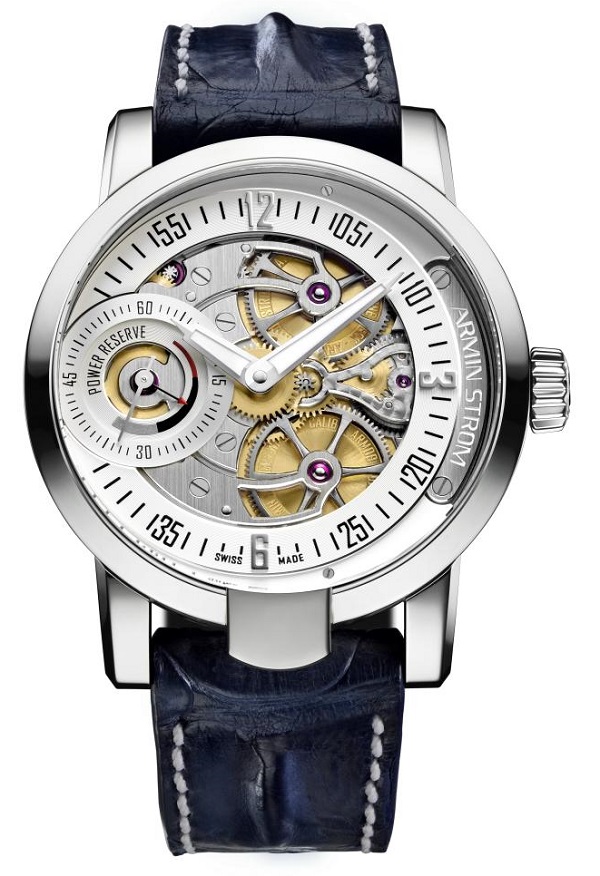In fact, that is one of the major things I like about companies like DeWitt – they do not produce the same old kinds of interchangeable horological items that can come from numerous brands. These are different works of art with a serious degree of mechanical idea and effort put into them. An interesting detail is that the signature on the back of each of DeWitt’s most complicated timepieces like the DeWitt Academia Grand Tourbillon. It was intriguing to view several different DeWitt timepieces and see a variety of names engraved in cursive font on the backs of the moves – a classy touch, should you inquire me.Speaking of the motion, let us talk about the in-house created DeWitt caliber DW 8030 that sits so well exposed interior of the DeWitt Academia Grand Tourbillon case. In many ways, the movement is extremely traditional regardless of the contemporary look of the case and the dial layout. Composed of 327 components, the DW 8030 movement builds on 2010’s caliber DW 8028 which was DeWitt’s first totally in-house tourbillon movement. The basic structure is the same, but the regulator-style time screen and a unique bridge design was contained from the DW 8030. This slower frequency can be desirable for tourbillons, as it allows for a greater visual appreciation of this oscillating balance wheel. The free-spring balance wheel is further fitted using a Spiral Straumann balance spring which has a Philips curve. Along with the time, the movement also offers a date index disk whose window is at 3 o’clock on the dial.
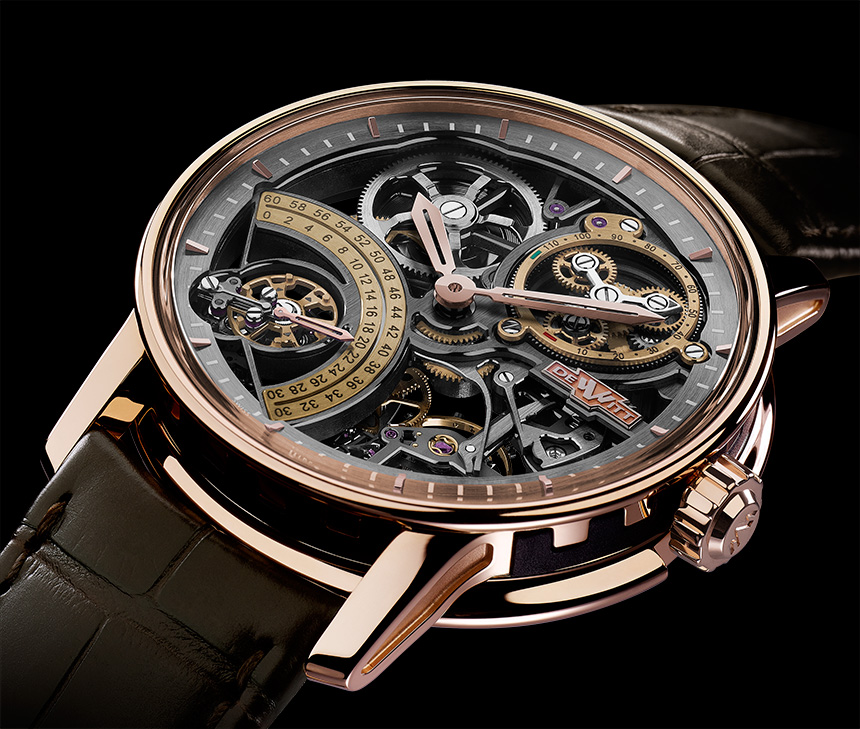
DeWitt is a very niche Swiss brand that likes to remind you that owner Jerome DeWitt is a descendent of Napoleon Bonaparte. While that is kind of cool for him, the brand mostly gets our attention with technical horology and unexpected designs. The avant-garde Academia collection with its rare complications is the brand’s signature, and the new DeWitt Academia Skeleton is the latest addition. While the name of the watch would seem to suggest that the skeletonization is the main show, it is the “bi-retrograde” seconds hand that stands out the most.
At Baselworld 2010 DeWitt surfaced their first in-house motion — Caliber DW8014. The automatic-winding movement boasts noteworthy technical characteristics at each end of the gear train.The mainspring is wound by a bi-directional peripheral rotor which allows an amazing view of the motion. The mainspring itself integrates DeWitt’s patented Automatic Sequential Winding (A.S.W.) platform that permits one barrel to distribute continuous energy to the equipment train whilst delivering a 72 hour power reserve. In the opposite end, a Straumann equilibrium spring with a Phillips terminal curve forces deadbeat seconds that are in direct contact with all the tourbillon cage.Outside, the watch pays tribute to Art Déco layout, and in particular to 1930s New York. The 46 millimeter round case is made of 18 carat rose gold. The multi-layer dial is controlled by a four-column vertical structure with the tourbillon in its base and bases adorned with a sunburst pattern distributing out to sides.Despite the use of the expression “Regulator” in the title, the watch has a traditional time display with center-mounted hour, minute and seconds hands. A power-reserve index is positioned at 9 o’clock. Complete specs look below the images, the first of which might be enlarged with a click.Jerome DeWitt is a charming man who knows how to generate suspense, and also how to make watches. We entered his elegant stall at Basel and were seated in comfortable chairs around a table. As the presentation began, Mr. DeWitt produced what seemed like a substantial watch on a small stand, covered with a cloth, and he put it on the desk, still coated. He moved like a magician carrying a bird simply put under a colorful silk. You know the bird is going to evaporate, which means you concentrate on it hoping to grab the trick. In this way I focused on the puzzle watch below the cloth as other watches were introduced. Eventually, the cover increased…
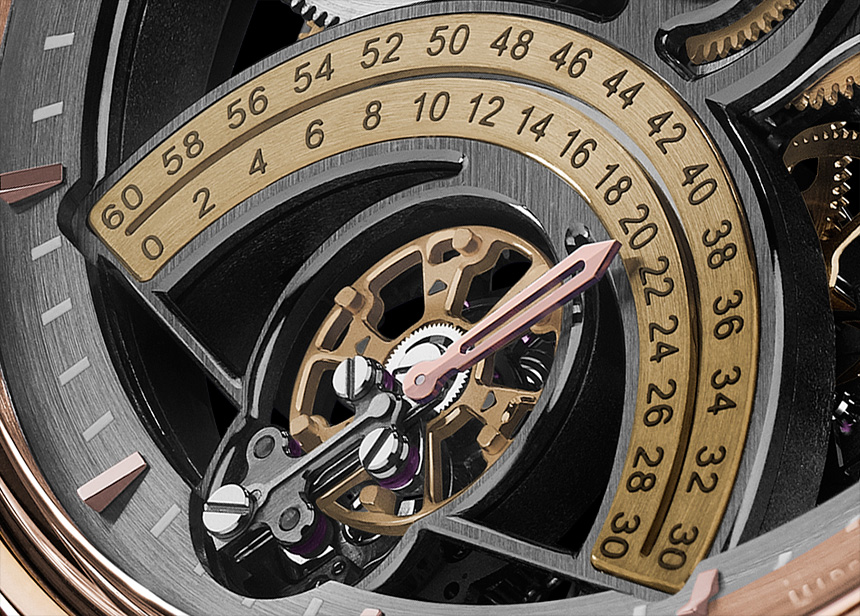
Note the giant semi-dial at 7 o’clock, with an inner 0-30 scale and outer 30-60 scale. It could have been a regular retrograde seconds hand that jumps back to the beginning – but no, we’ve seen that before. So, upon reaching the end of the lower scale at 30, the seconds hand juts forward to extend to the upper scale and begins its sweep slowly back in the opposite direction. At 60, of course, it retracts back to zero. The video will help you understand better than my description.
Perhaps my preferred version of this DeWitt Academia Out Of Time watch is the model with all the royal blue dial. Boy, does that one look cool. The odd moves on the dial combined with the identifying case and loudly dial make for a decidedly “courtly” wrist statement. Each, I feel, has its own significant place in the collection, and I further want to state that although this watch will not have an Academia-style case, the DeWitt Academia Out Of Time looks very distinctive one of the bigger DeWitt watch collection.Above, I mentioned that DeWitt makes all of their own movements. It’s rather impressive what the little brand does at their mill, and accurate enough, they create all their own things. Because of this, their movements frequently have a very original look to them for those which are fundamental. Power reserve is a decent 65 hours, and also the motion is made from 217 parts. I like the plan of this movement that exposes the gears with a more grand view as compared to many others, and also has that cool art deco-style automatic rotor layout with the castle-style crenelation around its edge to mimic the “columns” on the side of the watch case.The DeWitt Academia Out Of Time comes just in 18k rose gold (for the time being) in a 42.5mm broad case. That actually makes it among those smaller DeWitt watches on the market (for guys). The case is 12.85mm thick, and there is black rubberized inlaid into the face of the situation to further highlight the “DeWitt imperial column” theme that’s there. Or you might view the side of this case as looking like a row of angular (golden) robot teeth. Weird or not, I enjoy details like that as well as the detailing and various finishing on the lugs.
Note @ 7:00 the “bi-retrograde” seconds hand on the DeWitt Academia Skeleton watch that sweeps both ways like a windshield wiper, jumping between the upper and lower scales. @dewittwatches #dewitt #luxury #watches #watchporn #ablogtowatch
It’s really just a novel way of displaying the seconds, but let’s face it, mechanical watches are very much like tiny Rube Goldberg machines, anyway: exceedingly complex but mesmerizing ways of accomplishing relatively basic functions, such as indicating the time. And at the high end of horology, around DeWitt’s neighborhood, where little expense in terms of time or money is spared, it gets even more complex – and mesmerizing.
While we don’t have any caseback images of the watch, we can pretty clearly see everything going on in the movement from the dial side of the DeWitt Academia Skeleton. The power reserve of over 100 hours is displayed up around 2:30 – and we like power reserve indicators, particularly on manually wound movements like this DW1105S. But next to that, at around 10:30, you can see the large double barrel that is open to also show you exactly how tightly the mainspring is wound. And the balance wheel can be seen twitching away at 3Hz (21,600bph) around 4:30, providing even more eye-candy animation.
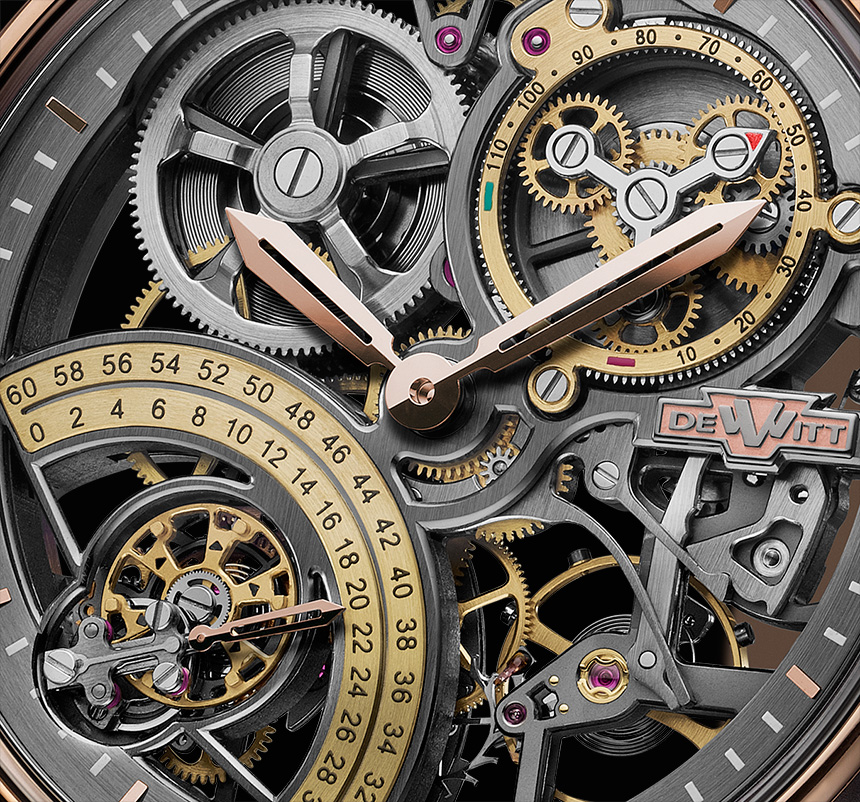
One reason things such as tourbillons are so popular is that they not only display the mechanical complexity we so enjoy watching, but they are highly animated. Simply finding a means to display the balance wheel from the dial side is another way many watchmakers have additional mechanical sparkle to a watch. Even only a sweeping seconds hand will do – cartoon of any sort adds a lot to a face. That’s why the windshield-wiper seconds, with its stabbing and jerkily retracting movement every thirty seconds, is worth all the obviously necessary extra engineering. That combined with the DeWitt Academia Skeleton’s “openwork” motion provides a good deal of horological entertainment for a cost of $85,800. Recently, while in Geneva, Switzerland, I had the opportunity to visit “manufacture DeWitt,” an impressive and resolutely market high-end watch maker who produces nearly everything themselves and is owned by Mr. Jerome DeWitt – whose family tree contains Napoleon Bonaparte. Jerome himself is a humble guy whose chief passions in life involve mechanical things. Jerome has the spirit of an artist who is deeply interested in mechanics and also the visual celebration. It is really his wife – who is now in a mutually job at the company – which attracted DeWitt back from some of its financial troubles. Together, the energetic DeWitt duo has strengthened the brand to create it the business of now I actually admire – a exceptional brand, whose timepieces all have something interesting to say (no matter whether or not you like that statement).
On top of all that and the contemporary skeletonized movement, the rose gold hands seem to do a pretty good job of being legible and contrasting with the mostly brushed “black gold” (not oil) surfaces. The rose gold hands match the DeWitt Academia Skeleton’s rose gold case that is 42.5mm wide and 10.25mm thick – which promises some wrist presence, but also to be pretty wearable. On the case sides, black rubber forms what the company calls “Dewitt imperial columns.” The DeWitt Academia Skeleton case is water resistant to 30m, no surprise there, and the lug width is a less common 21mm – so you may have a little more trouble finding a nato strap to fit it.
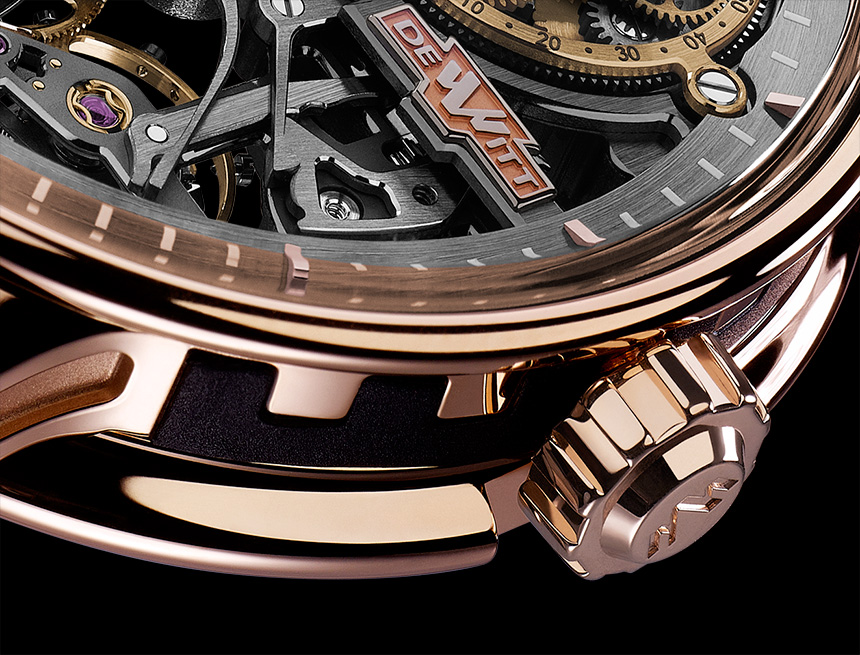
The Antipode will be generated in a limited collection of 25 bits. In case you need to ask, it is going to be priced at SFr. 420,000. All DeWitt watches are assembled by a single watchmaker from start to finish.Earlier in 2015, I had the opportunity to visit the watch manufacture of DeWitt in Geneva. The DeWitt brand has had its ups and downs through time along with the global economy, but has really sorted out its own organizational issues and is over back on track to creating a few of the most interesting and exclusive timepieces around – such as this quite rare DeWitt Academia Out Of Time collection. Why is DeWitt watches exclusive and interesting in my own opinion? Well, in addition to producing a whole universe of quite distinctive in-house made movements with some complications you won’t find anywhere else, DeWitt often employs designs and styles quite removed from the rest of the watch market. With that said, DeWitt is still completely a Swiss-born-and-bred watch firm living in harmony with other exceptional niche luxury brands.Someday, I’ll write more about Mr. Jerome DeWitt, the polite and shy lover of all things mechanical who’s both an ancestor of Napoleon Bonaparte and likely a genius of sorts – and Ms. DeWitt, the search motor behind the performance who speaks with New York-style purpose, and old-world landed aristocracy expectation.For now, I’d like to describe the DeWitt Academia Out Of Time watch and making this interesting timepiece. I sort of feel bad for men and women who aren’t able to find this view in person. You literally cannot know what the dial looks like in action without viewing it function. The main dial includes two subdials with the left being a “flying time” indicator and the right being a “beat second” indicator. What’s that all about? The beat seconds hand is no more than a dead seconds hand. DeWitt is actually into lifeless moments complications (consider for example the trendy DeWitt Academia Grand Tourbillon that we go hands-on with here). Those are when an otherwise sweeping seconds hand on a mechanical motion “ticks” similar to how moments hands operate on quartz watches. For watch lovers, the irony is wonderful (along with the history of the functionality).
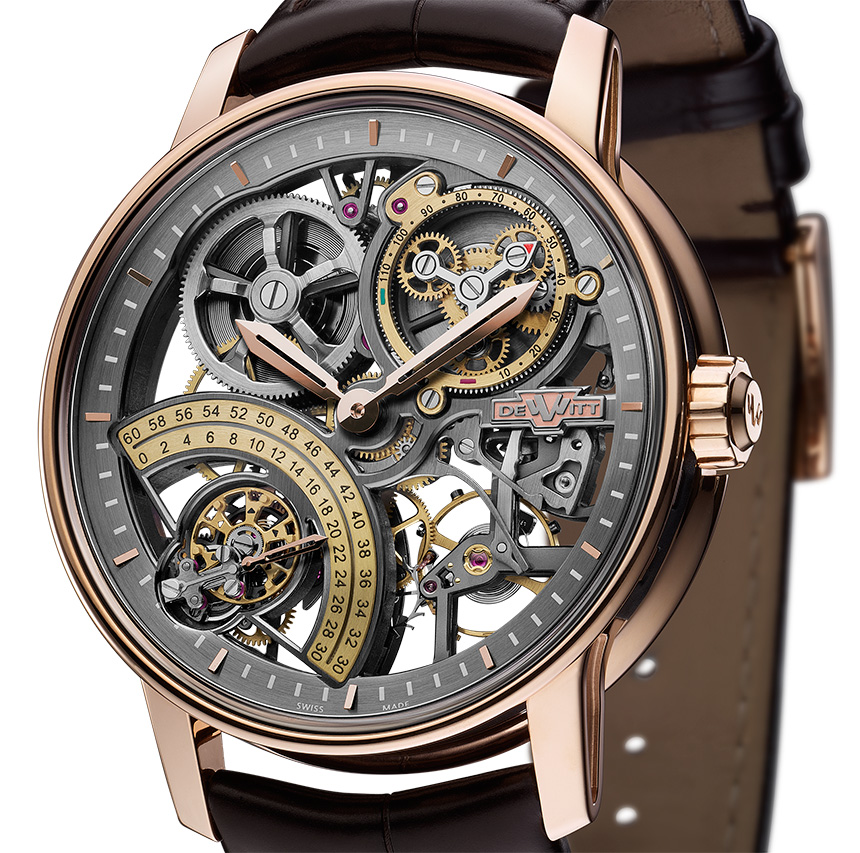
As boutique because the brand is (well they aren’t that boutique, given the size of this location) an impressive variety of new timepieces and movements are being produced in DeWitt on a normal basis. A fantastic illustration of their visual and technical strength is a timepiece set like this DeWitt Academia Grand Tourbillon view, which is fresh for 2015. It unites a skeletonized in-house-made tourbillon movement, a regulator style screen, as well as jumping indicators for the hours and minutes. If that does not make sense to you, then I have included a brief video I posted of this DeWitt Academia Grand Tourbillon watch that demonstrates how the hands move in “jumping steps” versus at a sweeping movement as on most other watches.What makes this jump hours and moments system so applicable on a regulator-style display (where the hours, minutes, and seconds are each indicated in their own different dial) is that, historically, these types of layouts were utilized on the most precise clocks (which were called regulator clocks). The name is based on the simple fact that the clocks were used to “regulate” the time of other clocks. Many of them had “dead seconds” hands which ticked versus sweeping for a more precise ability to browse the moment. While I really don’t know when this really is a novel concept (I sort of doubt that it entirely is) DeWitt has adopted the ticking concept of a dead seconds hand to the minute and hours hands. I find the concept interesting both emotionally and technically as the notion very much fits to the notion of idealized mechanical indication of the moment.
One of the reasons things like tourbillons are so popular is that they not only display the mechanical complexity that we so enjoy watching, but they are highly animated. Simply finding a way to display the balance wheel from the dial side is another way many watchmakers have added mechanical sparkle to a watch. Even just a sweeping seconds hand will do – animation of any kind adds a lot to a watch face. That’s why the windshield-wiper seconds hand here, with its stabbing and jerkily retracting motion every thirty seconds, is worth all the obviously necessary extra engineering. That combined with the DeWitt Academia Skeleton’s “openwork” movement provides a good deal of horological entertainment for a price of $85,800. dewitt.ch
… and fortunately the watch was still there. I’ve always said that everyone wants a sporty minute repeater tourbillon GMT. Award at Basel 2009. Unlike Mr. DeWitt, ” I will not keep you waiting for the magic. Press the Antipode’s lugs so, and they detach from the instance, allowing this opinion with two dials to rotate in an axel repaired at 12 and 6. It’s somewhat like a gigantic, around Reverso, just the whole case can spin. Upon finishing the 180° flip, the lugs click back into position and your friends smile in amazement.The tourbillon appears on the front part of the timepiece at the conventional 6 o’clock position, below the neighborhood hour and moment indications and the second repeater. On this side, the local time alert is triggered by a pushpiece situated at 9 o’clock on the instance. Perform the flip and the second face includes the GMT function together with the hour and minutes in the second time zone. The latter is put to time by means of a corrector positioned at 1 o’clock. The minute repeater mechanism might be activated at any moment, whichever side is observable, and its own chime will say the local time. Mr. DeWitt demonstrated, and the chime is clear and loud. The translucent dials offer a glimpse of this complicated, fully-integrated movement beneath.
… and fortunately the opinion was still there. I’ve always said that everyone needs a sporty moment repeater tourbillon GMT. If you do not have one yet, I’ve got great news: it is called the Antipode, and it finished a close second to Christophe Claret’s DualTow for the personal Holy Smokes! Award-winning Basel 2009. Contrary to Mr. DeWitt, ” I will not keep you waiting for the magical. It is a bit like a colossal, round Reverso, just the whole instance can twist. Upon completing the 180° reverse, the lugs return into place and your friends smile in amazement.The tourbillon appears on the front part of the timepiece at the conventional 6 o’clock position, below the local hour and moment indications and the second repeater. Perform the reverse and the second face features the GMT function along with the hour and minutes in the next time zone. The latter is put to time by means of a corrector positioned at 1 o’clock. The minute repeater mechanism might be activated at any moment, whichever side is observable, and its chime will say the local time. Mr. DeWitt revealed, and the chime is clear and loud. The translucent dials provide a glimpse of the complicated, fully-integrated movement beneath.

